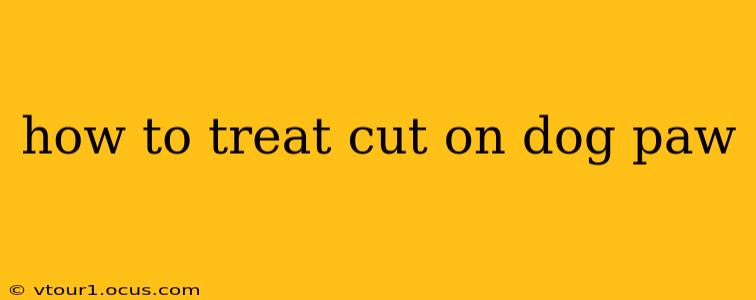A cut on your dog's paw can be distressing for both you and your furry friend. Dogs are constantly exploring their environment, making paw injuries relatively common. Knowing how to properly assess and treat these wounds is crucial for preventing infection and ensuring your dog's swift recovery. This guide will walk you through the steps, answering common questions along the way.
How Serious is My Dog's Paw Cut?
The severity of a paw cut varies greatly. Minor scrapes and superficial cuts require simple home care, while deeper wounds, bleeding profusely, or showing signs of infection need immediate veterinary attention. Always err on the side of caution. If you're unsure, consult your vet.
Signs a Vet Visit is Necessary:
- Deep wound: You can see deep tissue or bone.
- Heavy bleeding: The bleeding doesn't stop after 10-15 minutes of direct pressure.
- Signs of infection: Swelling, redness, pus, or a foul odor.
- Wound won't close: The edges of the cut remain widely separated.
- Your dog is limping excessively or showing signs of pain.
- Embedded debris: Something is stuck in the wound.
- The cut is on the paw pad itself: These are particularly sensitive and prone to complications.
How to Clean a Minor Cut on My Dog's Paw?
For minor cuts, cleaning is paramount. Follow these steps carefully:
- Restrain your dog safely: If your dog is struggling, you may need assistance. A calm and reassuring demeanor is crucial.
- Assess the wound: Gently examine the cut to determine its depth and extent.
- Clip the fur: Carefully trim the fur around the wound to allow for better cleaning and observation.
- Cleanse the wound: Use a clean, soft cloth or gauze pad dampened with lukewarm saline solution (available at most pharmacies) or a mild, veterinary-approved antiseptic solution. Avoid using hydrogen peroxide or alcohol, as these can damage tissue and delay healing. Gently wipe away dirt and debris. Avoid scrubbing.
- Apply antibiotic ointment (optional): A thin layer of a veterinarian-recommended antibiotic ointment can help prevent infection. Do not use human ointments without consulting your vet.
- Bandage (if necessary): If the wound is superficial and not bleeding, a bandage may not be necessary. If it is bleeding or needs protection, use a clean bandage, ensuring it's not too tight. Check regularly for any signs of irritation or infection.
What if My Dog is Licking Their Paw?
Licking is a natural canine behavior, but excessive licking can hinder healing and introduce bacteria. An Elizabethan collar (cone) can prevent your dog from licking or biting the wound while it heals. Talk to your vet about options to manage licking.
How Long Does it Take for a Dog Paw Cut to Heal?
Healing time depends on the wound's severity and your dog's overall health. Minor cuts usually heal within a week, while more significant injuries may take longer. Monitor the wound closely for any signs of infection.
What Kind of Antibiotic Ointment Should I Use?
Only use antibiotic ointments recommended by your veterinarian. Human ointments may not be appropriate for dogs and can cause adverse reactions. Your vet can advise on the best option for your dog's specific wound.
When Should I Take My Dog to the Vet? (Repeated for clarity and SEO)
As mentioned previously, it is crucial to seek veterinary care if the cut is deep, bleeds heavily, shows signs of infection, or if you are unsure about the severity of the injury. Your vet can provide proper assessment and treatment. Remember, early intervention is key to preventing complications.
My Dog's Paw Cut is Infected - What Now?
Signs of infection include increased swelling, redness, pus, foul odor, and increased pain or limping. Contact your veterinarian immediately if you suspect an infection. Delaying treatment can lead to serious complications, such as cellulitis or osteomyelitis.
By following these guidelines and seeking professional help when needed, you can ensure your canine companion receives the best possible care for their paw injury. Remember, responsible pet ownership includes knowing when and how to provide appropriate first aid.
